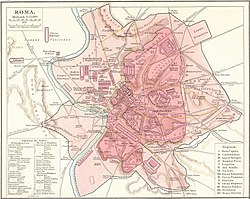Temple of Venus and Roma
 |
|
| Location | Regione VIII Forum Romanum |
|---|---|
| Built in | 135 AD |
| Built by/for | Hadrian |
| Type of structure | Roman temple |
| Related | List of ancient monuments in Rome |
The Temple of Venus and Roma Latin: Templum Veneris et Romae is thought to have been the largest temple in Ancient Rome. Located on the Velian Hill, between the eastern edge of the Forum Romanum and the Colosseum, it was dedicated to the goddesses Venus Felix ("Venus the Bringer of Good Fortune") and Roma Aeterna ("Eternal Rome"). The architect was the emperor Hadrian and construction began in 121. It was officially inaugurated by Hadrian in 135, and finished in 141 under Antoninus Pius. Damaged by fire in 307, it was restored with alterations by the emperor Maxentius.
In order to build the temple, erected on the remnants of the porticoed vestibule to Emperor Nero's Domus Aurea, the Colossus of Nero was moved and placed near the amphitheatre, which shortly afterwards became known as the Colosseum. Unimpressed by his emperor's architectural skills, Hadrian's most brilliant architect, Apollodorus, made a scornful remark on the size of the seated statues within the cellae, saying that they would surely hurt their heads if they tried to stand up from their thrones. Apollodorus was banished and executed not long after this.
According to the ancient historian Ammianus Marcellinus the temple was among the great buildings of Rome which astonished the Emperor Constantius II on his visit to the city in 357.
Further restoration was performed under Eugenius, a short-lived usurper (392–394) against Theodosius I, whose policy was the restoration of Pagan cults and temples. However, as with many of Rome's majestic ancient buildings the temple was later targeted for its rich materials. In 630 Pope Honorius I with the consent of the Emperor Heraclius, removed the gilt-bronze tiles from the roof of the temple for the adornment of St. Peter's.
...
Wikipedia

